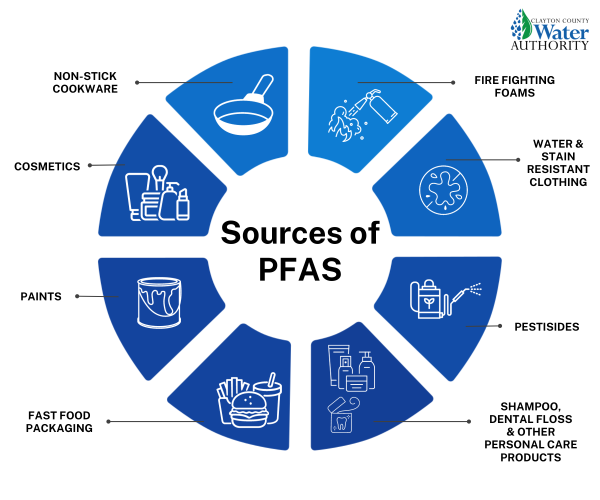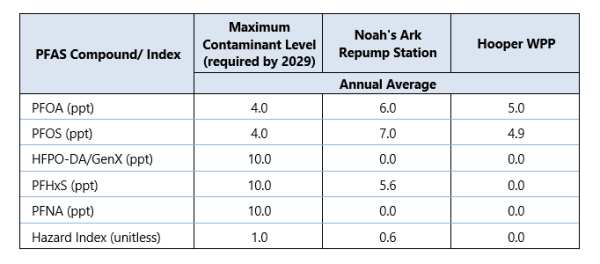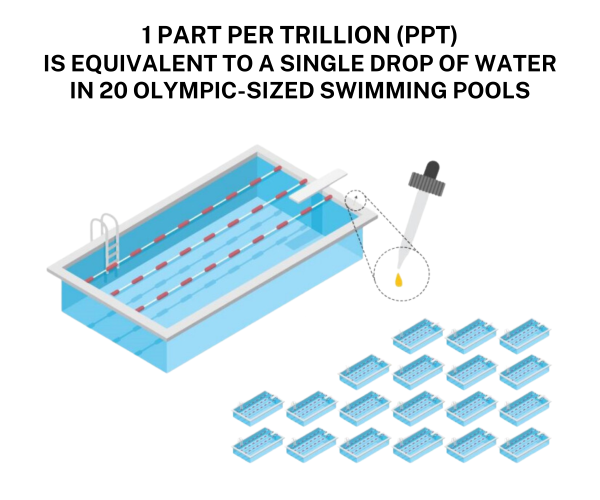Water & Your Health: PFAS
Clayton County Water Authority (CCWA) is at the forefront of public health and takes seriously our responsibility to deliver clean and safe drinking water to the community. As you are probably aware, there recently have been numerous national and local news stories on Per- and Polyfluoroalkyl (PFAS), and it being found in water, air and soil. Importantly, CCWA does not produce PFAS in our treatment process, as its presence is a result of industrial release and discharges from other sources. Here is some information to help explain PFAS and what we are doing here at CCWA.
“Clayton County Water Authority is at the forefront of public health and takes seriously our responsibility to deliver cle
an and safe drinking water to the community. As a reminder to our customers, Clayton County Water Authority is not the producer of any of these chemical compounds. However, we are tasked with the responsibility of treating and removing them, at significant cost to the Authority and you the consumer. We also want you to be aware that 20% of your exposure to PFAS/PFOA compounds comes from water, however 80% of them are from other household items.
We are currently meeting all regulatory requirements for safe drinking water. However now that EPA has moved forward with the new regulatory requirements, we will confidently move forward with making the necessary improvements. It is our goal and commitment to maintain the health/trust of our customers and our community. As a lifelong resident and customer of Clayton County Water Authority, I will continue to use and enjoy tap water. Clayton County Water Authority remains an award-winning utility who takes great pride in caring for one of the world’s greatest and life sustaining resources- WATER.”
Clayton County Water Authority’s team is a family of Innovative Industry Leaders who are customer and community focused!
H. Bernard Franks, Chief Executive Officer
FREQUENTLY ASKED QUESTIONS
What are PFAS?
PFAS are man-made chemicals that have been used in industry and consumer products worldwide since as far back as the 1940s. PFAS were created with the intent to make our lives easier. They have been used in non-stick cookware, water-repellent clothing, paper packaging for food, stain resistant fabrics and carpets, personal care products like shampoo, dental floss nail polish and eye makeup, some firefighting foams, and products that resist grease, water, and oil. The most commonly studied PFAS are perfluorooctanoic acid (PFOA) and perfluorooctane sulfonic acid (PFOS).

During production and use, PFAS can migrate into the soil, water, and air. Most PFAS (including PFOA and PFOS) do not breakdown, so they remain in the environment. Because of their widespread use and their persistence in the environment, PFAS are found in the blood of people and animals all over the world and are present at low levels in a variety of food products and in the environment. Some PFAS can build up in people and animals with repeated exposure over time.
How are people exposed to these man-made chemical compounds?
According to EPA’s analysis, 20% of an individual’s exposure comes from drinking water. The remaining 80 percent of exposure comes from consumer goods (cookware, food wrappers, cosmetics, stain/water resistant clothing, carpet and furniture treatments).
How does PFAS get into drinking water?
They can enter the environment from fire training and response sites, industrials sites, and landfills where the products are used or stored and then wash into local waterways and even groundwater sources. We did not produce PFAS or put these compounds in our drinking water, but we are committed to treatment processes that remove them. Our drinking water continues to meet all state and federal regulatory requirements.
What is CCWA doing about PFAS?
CCWA continues to be proactive, working to eliminate these man-made compounds. Our progress to date includes:
- September 2023 – CCWA was awarded a $16 million Drinking Water State Revolving Fund (DWSRF) loan by the Georgia Environmental Finance Authority (GEFA) to upgrade two of its water treatment plants to remove The 20-year GEFA loan has an interest rate of 1.63%. CCWA is eligible for this reduced interest rate because it is a WaterFirst Community. These funds will be used to fund the design phase for water treatment improvements. CCWA has also received a $14 million federal grant from GEFA’s Emerging Contaminants Communities Drinking Water Grant Program.
- September 2023 – CCWA began the litigation process of joining with other public water systems from across the United States in seeking cost recovery from manufacturers of PFAS which will serve to offset some of the costs associated with CCWA’s implementation of advanced treatment technology for the removal of PFAS from drinking water.
- February 2024 – CCWA issued a Request for Proposals (RFP) to select a contractor to design and build advanced water treatment facilities (such as reverse osmosis, granular activated carbon, etc.). This project will ensure all drinking water is in compliance with the PFAS National Primary Drinking Water Regulation.
- July 2024 – CCWA will recommend a contractor for completion of the project, in order to meet the regulatory deadline of 2029.
What are the EPA regulations on PFAS and how does CCWA water compare?
On April 10, 2024, the EPA established limits, called maximum contaminant levels (MCLs), that water utilities are required to meet by 2029. These MCLs are shown in the table below and range from 4 parts per trillion* (ppt) to 10 ppt, depending on the PFAS compound. The following summarizes the results CCWA would be reporting to GA EPD based on quarterly samples collected in 2023:
- The annual average PFOA and PFOS concentrations at both of CCWA’s entry points to the distribution system (i.e., Noah’s Ark Repump Station and Hooper Water Production Plant (WPP)) exceed the 4 ppt MCL that we are required to meet by 2029.
- The annual average HFPO-DA (GenX), PFHxS, and PFNA do not exceed the 10 ppt MCL.
- The Hazard Index, which accounts for the concentrations of HFPO-DA (GenX), PFHxS, PFNA and PFBS, compared to each compound’s health-based limit, does not currently exceed the MCL of 1 at either entry point to the distribution system.

*Note: A part per trillion is a measurement of the quantity of a substance in the air, water or soil. One part per trillion in water is equivalent to one drop of water in 20 Olympic sized pools, which average 660,000 gallons.
1 nanogram per liter (ng/L) is equal to 1 part per trillion (ppt).


